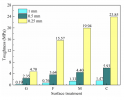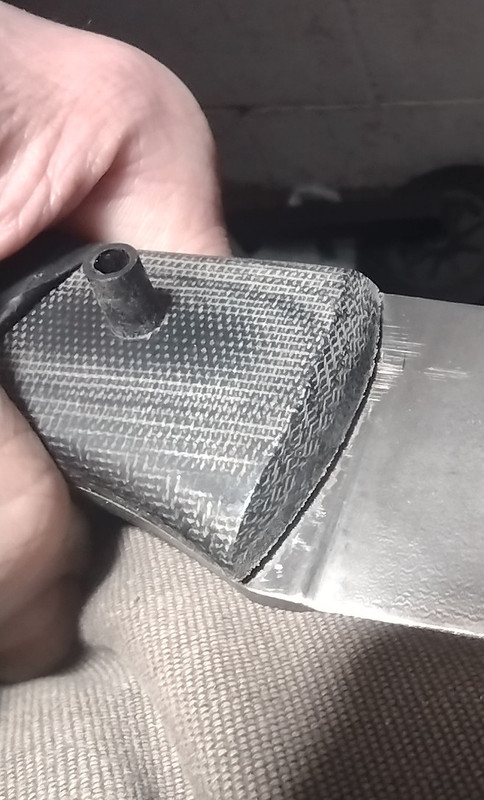- Joined
- Dec 5, 2005
- Messages
- 28,380
I get that, but do you think there is a greater risk of air pockets, particularly if a pin goes through the reservoir?Yep more surface area for the glue top adhere to.
The BladeForums.com 2024 Traditional Knife is available! Price is $250 ea (shipped within CONUS).
Order here: https://www.bladeforums.com/help/2024-traditional/
I get that, but do you think there is a greater risk of air pockets, particularly if a pin goes through the reservoir?Yep more surface area for the glue top adhere to.
 www.bladeforums.com
www.bladeforums.com

If you are using mechanical fasteners, it would not really matter if you sanded the surface or not. The epoxy is simply being used as a barrier from the elements.Thanks for posting that, Richard, it's a pretty stark data set
I mix my epoxy and apply it with a palette knife. Every surface gets epoxy and I apply it under a magnifier to make sure there are no bare spots.
this is obviously very interesting paper.A 2021 study seems pretty relevant.
https://www.sciencedirect.com/science/article/abs/pii/S0300944021000059
The link is an excerpt, but you can click on PDF to access a full open access version.
They tested the toughness of bonding between 2 pieces of mild steel, prepared with 4 different levels of surface roughness (400 grit, 60 grit, 36 grit, and 20 grit). For each of the 4 roughnesses, they tested 3 different thicknesses of epoxy (1mm, 0.5mm, and 0.25mm). 0.25mm is about 0.01".
For a given thickness of epoxy, the bond was improved by roughening the surface. For a given roughness, the bond improves strongly as the epoxy layer gets thinner. Unfortunately they didn't test even thinner layers, but the data are still rising steeply at 0.01" (0.25mm).
View attachment 2462347
My takeaway is to prepare the surfaces flat and sanded with 60 or coarser grit, and apply a thin layer of epoxy.
I would also like to see the results from this. It would also be my guess that chemicals bought at the hardware store have really minimal purity controls in place, and will likely leave crud on the surface.I'd love to hear your results from that test, please!! And, if it comes out good stuff, please post a photo of the can. Thanks and good luck with it. Hope it's clean.
Brake cleaner is a good choice, too!
This (thinner is better) is the result I would expect (read through my earlier thread on adhesion for the reasoning … focusing on the “weak chain link” analogy. *however* I do *not* discount stacy’s “epoxy reservoir” recommendation. Obviously experience says it helps… right now I can not reconcile the two perspectives.this is obviously very interesting paper.
I have read some of it because I was interested in the testing procedure.
I remember my dad saying to me that epoxy has a good strength in tension, but does not cope well with shear. I am not saying it is true, it's just a background.
I looked in the paper and they say they use "single lap shear (SLS) test". Which appears to be a test where they pull the joined pieces "along" the plane in which the adhesive was applied. Ok.
But for knifemakers, would even a simple hidden pin (i.e. a mechanical connection) increase strength in this type of load significantly? I suppose yes.
Then the next question is whether the glue strength is impacted by the surface roughness and thickness similarly in pure tension load (i.e. pulling the pieces apart perpendicularly to the plane in which the adhesive was applied).
Do you (by you I mean anyone) know if there is a difference between shear strength and tension strength in these modern epoxies? Just thinking out loud.
If we drill holes in scale for pins and then we insert pins/tight fit/ in scales ...no glue ,ONLY /safe/ way to disassemble scale is to push pins out . Attempting to disassemble scale from the ends or from any other direction can only break the wood, we will not disassemble the scales . We can do it, but it will take a long time, raise a little one end and then a little on the other side and so on ..Personally, I don't see the difference between a normal pin, penned pin or fasteners. Properly done, they will all do the job for which they are there .it seems to me that fasteners, pins or otherwise, provide a level of shearing resistance many times greater than any bonding agent.

( respectfully ) We can agree to disagree , IMO pins and good epoxy will make a trouble free knife handle.But a real knife that is going to be Used NEEDS mechanical fasteners too. Straight pins/tubing is Not good enough. (My opinion)
The issue for us in our workshops is that we do not enforce a standoff distance to set the layer thickness as they do in the study. We simply adjust how tightly we clamp and hope that we don't squeeze out all the glue.This (thinner is better) is the result I would expect (read through my earlier thread on adhesion for the reasoning … focusing on the “weak chain link” analogy. *however* I do *not* discount stacy’s “epoxy reservoir” recommendation. Obviously experience says it helps… right now I can not reconcile the two perspectives.
the greater strength in tension is a physical thing (edit - ie geometry), not chemical (again, read through that adhesion thread) … I would be surprised if current epoxies are any different (other than increased absolute strengths). Pins will definitely help protect against shear forces. Hidden pins would protect against those shear forces without being visible … and if well roughened would also provide some additional strength against tensile forces (ie forces that would tend to lift the scales away from the tang)
